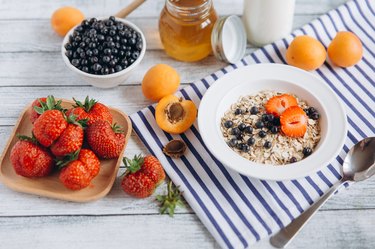
Microwaving is the quickest way to cook steel-cut oats. Other options, such as overnight oatmeal and slow-cooker oatmeal, also take little time to prepare. Whichever method you choose, the nutrition in this food makes it an unbeatable way to start a day.
Tip
To cook steel-cut oats in the microwave, a one part oats to four parts water. Use a large glass bowl, and microwave on high, covered, for five minutes, and then uncovered for five additional minutes.
Video of the Day
Steel-Cut Oats Microwave
Food.com offers a recipe for cooking steel-cut oats in the microwave. It has an oatmeal-to-water ratio of 1:4.
Video of the Day
Things You'll Need
½ cup steel cut oats
2 cups water
Instructions:
- Put the oats and water in a 2-quart, glass, microwaveable dish.
- Cover, and microwave on high for 5 minutes.
- Stir, and then cook, uncovered, for an additional 5 minutes.
Although the microwave method is fast, you can use other methods to cook the oats ahead of time. One of them, overnight oats, involves throwing ingredients into a container, to put in the refrigerator, the night before you need it. Recipes may call for oats and milk in a 1:4 ratio, as well as honey, raisins and spices like ginger and cinnamon. All you do is mix them together, and refrigerate. Eat heated or chilled.
You can also put oats in a slow cooker at bedtime, and wake up to a fabulous breakfast in the morning. These recipes may call for a 1:4 steel-cut oatmeal to water ratio, along with chopped apples, vanilla and cinnamon for flavoring. Simply mix the ingredients in the slow cooker, and cook on low for eight to nine hours. Serve with a little milk.
Read more: How to Make Overnight Oats
Types of Oats
What exactly are steel-cut oats, and how do they differ from other oats? Oatmeal ranges from varieties that undergo little processing to those that are highly processed. According to Iowa State University, the least-processed are newly harvested grain kernels with the hulls removed, a product called oat grouts. While supermarkets don't usually offer this food, they do carry steel-cut oats, which are grouts that have been cut into smaller pieces.
To make old fashioned oats, manufacturers steam oat grouts, and roll them into flakes, making them more processed than steel-cut oats. Instant, or quick rolled oats, are the most processed variety. Manufacturers make them by steaming oats longer, and rolling them thinner.
While instant oats offer the convenience of quick cooking, they aren't as healthy as the steel-cut variety. However, cooking steel-cut oats isn't any trouble if you use any of the three methods listed above: microwaving, slow cooking and preparing overnight oats.
Steel-Cut Oats Health Benefits
An October 2015 study published in The British Journal of Nutrition examined how different types of whole-grain oat cereals affect rate on the glycemic index. This index is a measurement of how rapidly a food causes an increase in blood glucose. The authors found that more processed oats, which have smaller particle sizes, had a higher glycemic index than the steel cut, or old fashioned, oats.
When steel-cut oats are compared to old fashioned oats, the nutritional profile is very similar. They contain roughly the same number of calories and relative amounts of protein, carbohydrates and fiber. However, in addition to having a healthier glycemic index, the steel-cut oats yield a larger serving portion, which means you ingest fewer calories, says Colorado State University. Clearly, steel-cut oats are the healthiest variety.
Read more: What Is the Nutritional Value of Oatmeal?
All oats are associated with an array of health benefits. These include improved bowel function, immunity and appetite control, as well as lower LDL, or bad, cholesterol, and a reduced risk of type 2 diabetes, according to the Whole Grains Council.
- Food.com: "Quick (Microwave) and Nutritious Steel Cut Oatmeal"
- Iowa State University: "News You Can Use October 2016"
- The British Journal of Nutrition: "Systematic Review of the Effect of Processing of Whole-Grain Oat Cereals on Glycemic Response"
- Whole Grains Council: "Health Benefits of Oats"
- Colorado State University: "Nutrition News – What’s the Deal With Steel-Cut Oats?"